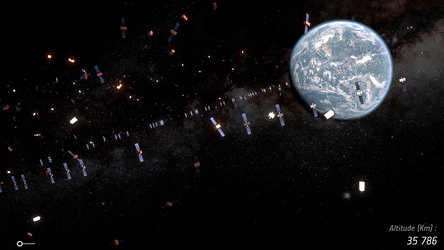Why monitor objects in orbit?
Today, Europeans rely on space-borne assets to support a wide and growing range of activities in daily life. Our space dependence is both visible and hidden; the apparent ones, such as our navigation systems and entertainment networks, are widely recognised as depending on satellites functioning continuously and safely in orbit.
Other aspects of our dependence, however, are more subtle and their benefits are less obvious, but by no means less important. These are just some of the space-based benefits on which European citizens rely:
- Navigation and door-to-door guidance through Global Navigation Satellite Systems (GNSS) such as GPS and Galileo
- Accurate time-keeping to ensure the integrity of banking systems and the secure transfer of funds between banks
- Internet access in rural communities
- HDTV entertainment broadcast
- Live news and sports coverage from around the globe
- Monitoring of crops and analysis of growing methods
- Disaster relief assistance through rapid imagery and communication support for emergency services
- Maritime security and tracking of goods
- Military intelligence gathering and secure communications
This is not an extensive list, but provides a snapshot of some of the 'hidden' benefits that space delivers to all European citizens. As technology improves, additional services will be added and our reliance will increase.
Situational awareness: knowing what goes on in space
Without a 'situational awareness' of all objects in orbit, Europe is flying blind: European satellite operators must trust to luck that services will remain uninterrupted.
Without this awareness, the situation in space can be compared to someone trying drive a car without the benefits of sight, sound or touch. We do not know which lanes are busy or if traffic is approaching or from what direction - we just know that we have to move forward. With so much at stake, it is not surprising that Europe has decided to acquire a comprehensive surveillance system.
Orbital debris mean danger
Space debris are defined as all non-functional, man-made objects, including fragments and elements thereof, in Earth orbit or re-entering into the Earth atmosphere.
Is is estimated that the total number of space debris objects in Earth orbit is on the order of:
- 20 000 - for sizes larger than 10 cm
- 600 000 - for sizes larger than 1 cm
- more than 300 million - for sizes larger than 1 mm
Any of these objects can cause harm to an operational spacecraft, where a collision with a 10-cm object would entail a catastrophic fragmentation, a 1-cm object will most likely disable a spacecraft and penetrate the ISS shields, and a 1-mm object could destroy sub-systems on board a spacecraft.
The problem is compounded when you consider that satellites orbiting close to the Earth, such many Earth observation satellites, travel constantly at over 30 000 km/hr.
Sources of space debris
Most of the orbital debris objects are the residue from man-made systems.
They can be defunct satellites, nuts, bolts, fragments from explosions and results from anti-satellite tests. The design of most operational satellites ensures that they can survive collisions with objects with a diameter of under one centimetre.
ESA's Space Debris Office has gathered data indicating that there are over 600 000 objects in orbit that have a diameter of one centimetre or over – and the number is growing all the time.
| This article continues... |
|
| Next: Europe flies unprotected |
|





